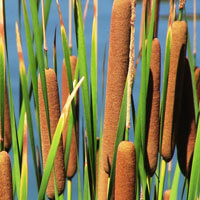
Cattails, with their towering stalks and fluffy seed heads, can be a picturesque addition to a pond. Aquatic plants can be a problem if they grow too much. They block sunlight and crowd out other aquatic life.
If you’re battling a cattails in your pond, you’re not alone. This guide will discuss ways to control the annoying plants, such as using tools like the Jenson Lake Mower and herbicides.
Understanding the Cattail Problem
Before diving into control methods, it’s crucial to understand why cattails are such a persistent issue. The plants develop strong roots that spread quickly, which makes them difficult to remove. They also make lots of seeds, spreading easily. Left unchecked, cattails can dominate a pond ecosystem, harming fish, waterfowl, and other aquatic plants.
Mechanical Control: The Jenson Lake Mower and Beyond
One of the most environmentally friendly approaches to cattail control is mechanical removal. The Jenson Lake Mower specifically designed to tackle aquatic vegetation. These mowers cut through the plants’ tough stems, preventing them from reseeding.
How to use a mechanical weed cutter:
- Timing is crucial: Mow them when they are young for optimal results.
- Consistent mowing: Repeated cutting can weaken the plant’s root system over time.
- Remove cuttings: Dispose of the cuttings properly to prevent them from re-rooting.
Mechanical methods can work well, but they may not completely get rid of cattails, especially in deep water or with a lot of them. In such cases, a combined approach with herbicides might be necessary.
Chemical Control: Herbicides for Management
Farmers can use herbicides to control weeds, but they need to be careful and follow the instructions on the label. Always prioritize environmental safety and choose herbicides specifically designed for aquatic use.
Common herbicides for cattail control include:
- Glyphosate: A broad-spectrum herbicide that can be effective on cattails. However, it can also harm desirable plants, so careful application is essential.
- 2,4-D: Another common herbicide, but its effectiveness on cattails can vary.
- Imazapyr: Imazapyr is made for killing water plants. It is less harmful to fish and other marine animals.
Herbicide application tips:
- Target the leaves: Apply herbicide directly to the leaves of the for maximum impact.
- Follow label instructions: Adhere to the recommended dosage and application methods to avoid harming other plants and aquatic life.
- Consider water conditions: Factors like water temperature and pH can affect herbicide efficacy.
- Monitor for non-target impacts: Regularly inspect the pond for any unintended effects on other plants or fish.
A Combined Approach for Optimal Results
For persistent cattail infestations, combining mechanical and chemical control methods often yields the best results. Start by cutting back the weeds with a mechanical cattail cutter like the Jenson Lake Mower to reduce their density. Then, apply an appropriate herbicide to target the weakened plants.
Prevention and Long-Term Management
Preventing overgrowth is key to maintaining a healthy pond ecosystem. Consider the following tips:
- Manage water levels: Fluctuating water levels can discourage cattail growth.
- Introduce competition: Planting desirable aquatic plants can help compete with cattails for space and nutrients.
- Regular monitoring: Keep a close eye on your pond for early signs of cattail infestation.
- Consider biological control: Research is studying using natural enemies to control cattails, but it’s not widely used yet.
By using both mechanical and chemical control methods, along with preventative measures, you can control cattail populations in your pond and restore balance to this valuable aquatic habitat.

